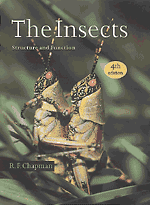Book contents
- Frontmatter
- Contents
- Preface
- Acknowledgments
- PART I The Head, Ingestion, Utilization and Distribution of Food
- PART II The Thorax and Locomotion
- PART III The Abdomen, Reproduction and Development
- PART IV The Integument, Gas Exchange and Homeostasis
- PART V Communication
- 20 Nervous system
- 21 Endocrine system
- 22 Vision
- 23 Mechanoreception
- 24 Chemoreception
- 25 Visual signals: color and light production
- 26 Mechanical communication: producing sound and substrate vibrations
- 27 Chemical communication: pheromones and chemicals with interspecific significance
- Taxonomic index
- Subject index
21 - Endocrine system
Published online by Cambridge University Press: 05 June 2012
- Frontmatter
- Contents
- Preface
- Acknowledgments
- PART I The Head, Ingestion, Utilization and Distribution of Food
- PART II The Thorax and Locomotion
- PART III The Abdomen, Reproduction and Development
- PART IV The Integument, Gas Exchange and Homeostasis
- PART V Communication
- 20 Nervous system
- 21 Endocrine system
- 22 Vision
- 23 Mechanoreception
- 24 Chemoreception
- 25 Visual signals: color and light production
- 26 Mechanical communication: producing sound and substrate vibrations
- 27 Chemical communication: pheromones and chemicals with interspecific significance
- Taxonomic index
- Subject index
Summary
Hormones are chemicals produced by an organism which circulate in the blood to regulate its long term physiological, developmental and behavioral activities. They complement the nervous system, which provides shortterm coordination, and the activities of the two systems are closely linked.
General aspects of hormones are discussed in this chapter. The specific actions of hormones regulating particular functions are considered in other chapters:
molting and metamorphosis – Section 15.4.
yolk synthesis – Section 13.2.4.2.
embryonic cuticles – Section 14.2.10.
diuresis – Section 18.3.3.
mobilization of fuel for flight – Section 9.12.2.
polyphenism – Section 15.5.
diapause – Section 15.6.5.
General review of insect hormones: Nijhout, 1994
CHEMICAL STRUCTURE OF HORMONES
Apart from molting hormone and juvenile hormone, most known insect hormones are peptides. Some biogenic amines are also known to function as hormones.
Molting hormones
Molting hormones are ecdysteroids (Fig. 21.1) which, in immature insects, are produced by the prothoracic glands. In most insects these glands secrete ecdysone, but some larval Lepidoptera are also known to secrete 3-dehydroecdysone which is converted to ecdysone by enzymes in the hemolymph (Fescemeyer et al., 1995). Ecdysone is a prohormone; it is converted to the active hormone, 20-hydroxyecdysone, in the fat body or epidermis by a cytochrome P-450 enzyme. In the honeybee Apis, and in Heteroptera, the principal ecdysteroid is makisterone A.
Insects cannot synthesize steroids. Consequently, sterols, usually cholesterol or a closely related structure, are essential dietary constituents.
Information
- Type
- Chapter
- Information
- The InsectsStructure and Function, pp. 570 - 584Publisher: Cambridge University PressPrint publication year: 1998
